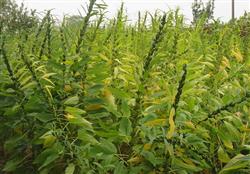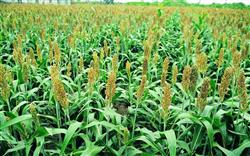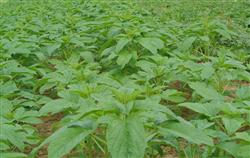How to manage planting sesame seeds in summer?

How to manage planting sesame seeds in summer? Please introduce the method of planting sesame in summer can be managed with reference to the following methods: first, three to five days after the emergence of sesame seedlings, the first pair of true leaves (called "cross" by farmers) are planted for the first time. When the second and third pairs of true leaves appear in sesame, the second seedling should be carried out, at this time, the weak seedling should be removed and the strong seedling should be retained, and the seedling should be initially fixed. In order to prevent the occurrence of diseases and insect pests and mechanical damage in the process of seedling setting, it is appropriate to divide seedlings into three stages, that is, one thinning, two seedlings and three fixed seedlings. The method is: sparse and dense, sparse, not sparse, not dense and strong seedlings. It is necessary to keep it evenly and thickly, without leaving two seedlings. Second, ploughing and cultivating the soil, the farmer said, "Sesame flower head three grasp." When the first and second pairs of true leaves appear, the first intertillage should be carried out, but it is appropriate to hoe the topsoil; when the third pair of true leaves appears, the second intertillage should be carried out, this time it can be ploughed 3 cm deep and 6 cm deep as the second grasping; when the fourth to fifth pairs of true leaves appear, the third intertillage should be carried out, and the depth of intertillage can reach about 8 cm. The second and third cultivation of soil can play the role of weeding and sealing roots, which is beneficial to the growth of roots, prevent waterlogging, reduce the occurrence of diseases, inhibit the growth of weeds and prevent lodging. Third, the scientific use of water sesame is extremely sensitive to the demand for water, can not be dry for a long time and cannot be waterlogged. The water demand of sesame at seedling stage is relatively small, and if the soil moisture is good when sowing, it can meet the water requirements of the plant, but not watering. But entering the flowering and capsule period is very sensitive to water requirements, at this time both afraid of waterlogging, but also afraid of drought, we must pay attention to timely watering in case of drought, timely drainage in case of waterlogging. The water requirement decreases gradually to the peak stage, and if the humidity remains good during the flowering and capsule period, then generally no watering is needed. 4. Extra-root topdressing needs a large amount of fertilizer from the early flowering stage to the full flowering stage of sesame. In order to prevent the lack of fertilizer at this time, it is most suitable to apply available nitrogen fertilizer before the early flowering stage. At the budding and flowering stage, the demand for phosphorus and potassium in sesame increases obviously, but it is suitable to spray topdressing at this time. 100 kg of water is sprayed with 0.25 kg potassium dihydrogen phosphate, and then sprayed once every 3 to 5 days. Fifth, the main diseases of sesame to control diseases and insect pests are stem point blight, bacterial wilt, Fusarium wilt, bacterial wilt, fungal angular spot and so on. Control methods: ① drainage and waterlogging prevention, ② reasonable crop rotation, ③ selection of disease-resistant varieties, ④ chemical control, such as root spraying treatment with 2000 times of 50% topiramate or 1 ∶ 1 ∶ 300 Bordeaux solution, etc. Pests include land tigers, aphids, sesame moths, blind Toona sinensis, mole crickets, etc., and spray 75 kg of water with 80% dichlorvos emulsion 100 ml per mu. 6. timely harvest sesame can mature 15-25 days after the final flowering period. Its characteristic is that the stems, leaves and fruits change from cyan to yellow, and the fallen leaves reach 70% to 80%, at the same time, there is a small amount of capsule cracking, which can be harvested at this time. After harvest, sun exposure, threshing, processing and finally storage were carried out. Click to get more sesame planting techniques click to get more food crop planting techniques
- Prev

What if the sorghum falls down?
What if the sorghum falls down? Please give guidance to sorghum root toppling can be carried out immediately, use the leaves of the stem itself to tie 3-5 plants together, the intersection of the two rows tied in the middle and upper part of the plant, so that each plant has a certain inclination, the ear should not overlap and squeeze, but should be crossed. When bundling, use as few leaves as possible to protect.
- Next

How to weed at the seedling stage of sesame in summer?
How to weed at the seedling stage of sesame in summer? Please introduce the weeding of sesame seedlings in summer can refer to the following methods: first, soil closure treatment before seedling after sowing. After sowing sesame seeds are sprayed evenly with 50% Acetochlor EC 100 ml or Dur (72% Metolachlor EC) 200 ml plus 50 kg water per mu.
Related
- The first cup of black tea in spring, the flavor and history of tea gardens in Kenya, Africa
- The computer can not only choose potatoes, but also grow tea rice. AI will grow winter oolong tea champion.
- It is not only the inflated tea bitten by insects, but also engraved with the four seasons tea in Beipu.
- The Oriental Beauty Tea Festival in Zhuxian County takes the stage at the weekend to experience the plus-size feast of oil tea.
- & quot; Oriental Beauty Tea & Exploration of Emei in Hsinchu, the hometown of quot;
- The new variety of strawberry "Tainong 1" dessert is the first choice with mellow aroma. Crimson gorgeous
- History of Tea in Taiwan: from Wild Inner Mountain to Export Tea Garden
- Two types of Taiwan Oriental Beauty Black Tea won the British three-Star Award for Childhood Tea Xiang Zhang Jiaqi changed from pilot to champion tea maker.
- Banana species and varieties: the planting history of Taiwan Xianren banana and dwarf banana is long, is banana disease resistant?
- Coffee planting Technology: Qianjie Coffee from Seedling to harvesting

